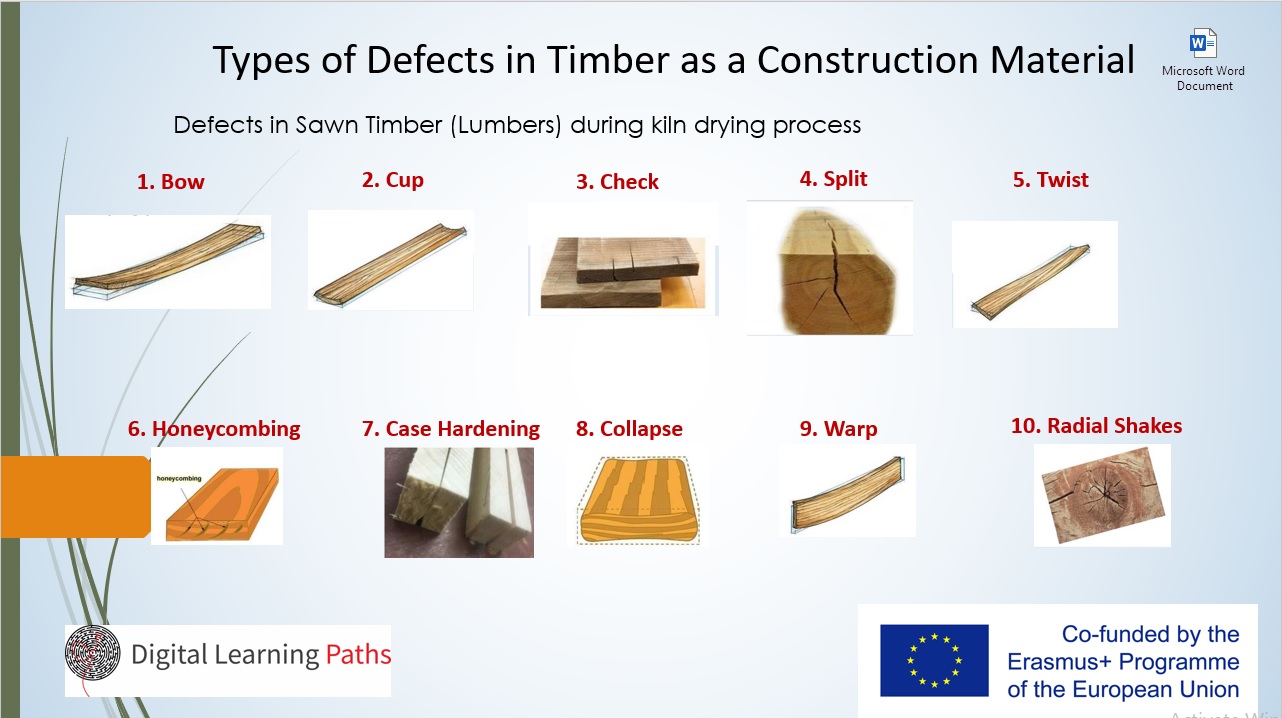Types of Defects in Timber as a Construction Material – Defects in Sawn Timber
Students will learn what types of defects in timber as construction material there are.
Students look at the image and learn what types of defects in timber as construction material there are.
Photos from:
https://theconstructor.org/building/types-of-defects-in-timber/21521/
https://www.eximcorp.co.in/amp/assets/files/wood-defects.pdf

Students read the text and get the basic info about what types of defects in timber as construction material there are.
Types of Defects in Timber as a Construction Material
Common Defects in Sawn Timber (Lumbers)
No tree is perfect. It’s subject to defects from the time it emerges as a seedling to the last stages of Seasoning/drying. A defect is simply an abnormality or irregularity found in wood. There are many different types of defects arising from many different causes. For instance, there are natural and acquired defects caused by a broken limb or other injury, insect and fungal attack, or rapid tree growth. There are innate defects caused by the natural characteristic of wood to shrink or expand in response to water vapor in the air. And, there are artificial and mechanical defects caused by incorrect sawing or machining (conversion), improper drying (seasoning), or improper handling and storage. Defects may be responsible for reducing wood’s economic value, lowering its strength, durability, and usefulness, marring its appearance, and in some cases, causing its decay. This document is an attempt to classify the inherent defects in the wood with reference to the causation of such defects.
Defects in Sawn Timber (Lumbers) during kiln drying process
- Bow
When the converted timber is stored for a longer time, some timber planks may have a curve along its length without sufficient block support, which is known as Bow.
- Cup
If the timber planks curve along their width, then it is called the Cupping of timber.
- Check
Check is the formation of a crack in the wood, which will separate the wood fibers. They form due to over over-seasoning of timber
- Split
Split forms when a check extends from one end to the other end, which will split the wood into a number of pieces.
- Twist
Twist forms when the timber piece is distorted spirally along its length. It looks like a propeller blade after twisting.
- Honeycombing
Honeycombing occurs in the inner part of the timber, which cannot be identified by just seeing. It is mainly due to stresses developed during the drying of timber.
- Case Hardening
The case is nothing but the top surface of wood, which dries rapidly during seasoning, but the inner part doesn’t. Then this defect is called case hardening.
- Collapse
During drying, some parts of the wood may dry rapidly while some may not. Because of this, improper drying shrinkage of wood occurs, which results in a defect called collapse.
- Warp
Warping is the loss of shape of wood due to stresses developed during drying. Cupping bowing, and twisting of wood come under warping
- Radial Shakes
Radial shakes develop after the tree is felled down and exposed to the sun for seasoning. In this case, the cracks run radially from the bark to the pith through annual rings.
Students watch the video and get the general knowledge about what types of defects in timber as construction material there are.
Students do the quiz and check their learning achievements
Add text for this activity
Resource information